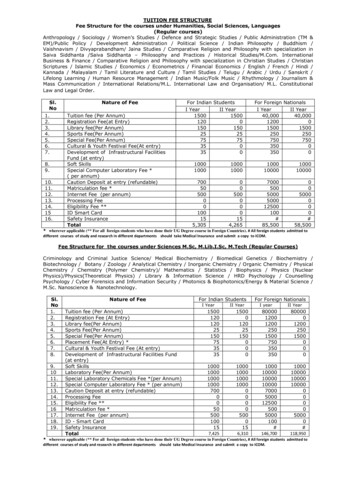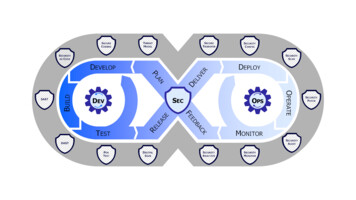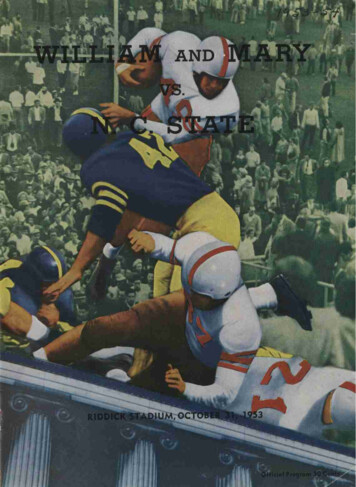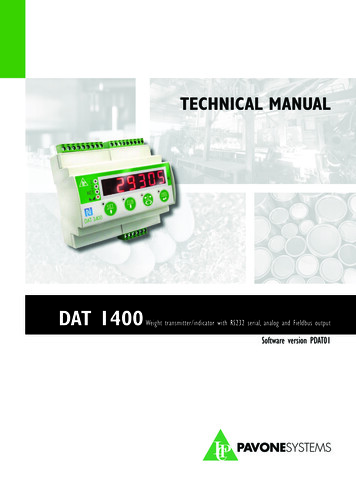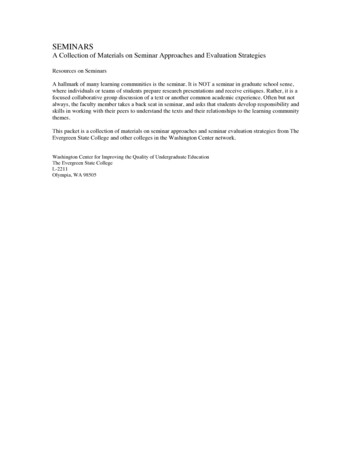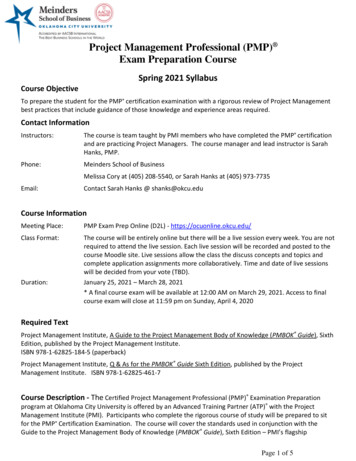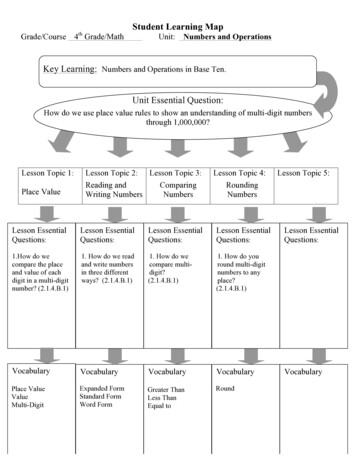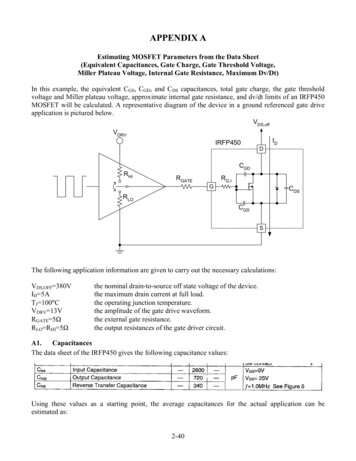
Transcription
APPENDIX AEstimating MOSFET Parameters from the Data Sheet(Equivalent Capacitances, Gate Charge, Gate Threshold Voltage,Miller Plateau Voltage, Internal Gate Resistance, Maximum Dv/Dt)In this example, the equivalent CGS, CGD, and CDS capacitances, total gate charge, the gate thresholdvoltage and Miller plateau voltage, approximate internal gate resistance, and dv/dt limits of an IRFP450MOSFET will be calculated. A representative diagram of the device in a ground referenced gate driveapplication is pictured GSSThe following application information are given to carry out the necessary calculations:VDS,OFF 380VID 5ATJ 100 CVDRV 13VRGATE 5ΩRLO RHI 5Ωthe nominal drain-to-source off state voltage of the device.the maximum drain current at full load.the operating junction temperature.the amplitude of the gate drive waveform.the external gate resistance.the output resistances of the gate driver circuit.A1.CapacitancesThe data sheet of the IRFP450 gives the following capacitance values:Using these values as a starting point, the average capacitances for the actual application can beestimated as:2-40
Equations:C RSS,ave 2 C RSS,spec C OSS,ave 2 C OSS,spec Numerical Example:VDS,specVDS,offVDS,specVDS,offC RSS,ave 2 340pF 25V 174pF380VC OSS,ave 2 720pF 25V 369pF380VThe physical capacitor values can be obtained from the basic relationships:C GD C RSS,aveC GD 174pFC GS C ISS C RSSC GS 2600pF 340pF 2260pFC DS C OSS,ave C RSS,aveC DS 369pF 174pF 195pFNotice that CGS is calculated from the original data sheet values. Within one equation, it is important touse capacitor values which are measured under the same test conditions. Also keep in mind that CGS isconstant, it is not voltage dependent. On the other hand, CGD and CDS capacitors are strongly non-linearand voltage dependent. Their highest value is at or near 0V and rapidly decreasing as the voltageincreases across the gate-to-drain and drain-to-source terminals respectively.A2.Gate chargeThe worst case gate charge numbers for a particular gate drive amplitude, drain current level, and drainoff state voltage are given in the IRFP450 data sheet.13V122nCCorrecting for a different gate drive amplitude issimple using the typical Total Gate Charge curve asillustrated on the left.Starting from the 13V gate-to-source voltage on theleft hand side, find the corresponding drain-tosource voltage curve (interpolate if not givenexactly), then read the total gate charge value on thehorizontal axes.If a more accurate value is required, the differentgate charge components must be determinedindividually. The gate-to-source charge can beestimated from the curve on the left, only the correctMiller plateau level must be known. The Millercharge can be calculated from the CRSS,AVE valueobtained in A1. Finally, the over drive chargecomponent – raising the gate-to-source voltage fromthe Miller plateau to the final amplitude – should beestimated from the graph on the left again.2-41
A3.Gate threshold and Miller plateau voltagesAs it was already shown in A2, and will be demonstrated later, several MOSFET switchingcharacteristic are influenced by the actual value of the gate threshold and Miller plateau voltages. Inorder to calculate the Miller plateau voltage, one possibility would be to use the gate-to-source thresholdvoltage (VTH) and transconductance (gfs) of the MOSFET as listed in the data sheet.Unfortunately, the threshold is not very well defined and the listed gfs is a small signal quantity. A moreaccurate method to obtain the actual VTH and Miller plateau voltages is to use the Typical TransferCharacteristics curves of the data sheet.From the same temperature curve, pick two easy toread points and note the corresponding draincurrents and gate-to-source voltages. Select thedrain current values to correspond to vertical gridlines of the graph, that way the currents can be readaccurately. Then follow the intersections to thehorizontal axes and read the gate-to-source voltages.Starting with the drain currents will result in higheraccuracy because the gate-to-source voltage is on alinear scale as opposed to the logarithmic scale indrain current. It is easier to estimate Vgs1 and Vgs2on the linear scale therefore the potential errors aremuch smaller.For this example, using the 150 C curve:I D1 3AID2ID1VGS2VGS1VGS1 4.13VTypical Transfer CharacteristicsI D2 20AVGS2 5.67VThe gate threshold and Miller Plateau voltages can be calculated as:2I D1 K (VGS1 VTH )I D2 K (VGS2 VTH )2VTH K VGS1 I D2 VGS2 I D1I D2 I D1I D1(VGS1 VTH )2VGS,Miller VTH I LOADK4.13V 20A 5.67V 3A 3.157V20A 3A3AK 3.169(4.13V 3.157V )2VTH VGS,Miller 3.157V 2-425A 4.413V3.169
These values correspond to 150 C junction temperature, because the 150 C curve from the TypicalTransfer Characteristics was used. Due to the substantial temperature coefficient of the thresholdvoltage, the results have to be corrected for the 100 C operating junction temperature in this application.The gate threshold voltage and the Miller plateau voltage level must be adjusted by: VADJ (TJ 150 C ) TCVöæ VADJ (100 C 150 C ) ç 0.007 0.35V C øèA4.Internal gate resistanceAnother interesting parameter is the internal gate mesh resistance (RG,I), which is not defined in the datasheet. This resistance is an equivalent value of a distributed resistor network connecting the gates of theindividual MOSFET transistor cells in the device. Consequently, the gate signal distribution within adevice looks and behaves very similar to a transmission line. This results in different switching times ofthe individual MOSFET cells within a device depending on the cells distance from the bound pad of thegate connection.The most reliable method to determine RG,I is to measure it with an impedance bridge. The measurementis identical to the ESR measurement of capacitors which is routinely carried out in the lab. For thismeasurement the source and drain terminals of the MOSFET are shorted together. The impedanceanalyzer should be set to RS-CS or if it is available RS-CS-LS equivalent circuit to yield the componentvalues of the equivalent gate resistor, RG,I, the MOSFET’s input capacitance, CISS and the series parasiticinductance of the device, all connected in series.For this example, the equivalent component values of an IRFP450 were measured by an HP4194impedance analyzer. The internal gate resistance of the device was determined as RG,I 1.6Ω. Theequivalent inductance was measured at 12.9nH and the input capacitance was 5.85nF.A5.dv/dt limitMOSFET transistors are susceptible to dv/dt induced turn-on only when their drain-to-source voltagerises rapidly. Fundamentally, the turn-on is caused by the current flowing through the gate-draincapacitor of the device and generating a positive gate-to-source voltage. When the amplitude of thisvoltage exceeds the gate-to-source turn-on threshold of the device, the MOSFET starts to turn-on. Thereare three different scenarios to consider.First, look at the capacitive divider formed by theCGD and CGS capacitors. Based on these capacitorIRFP450values the gate-to-source voltage can be calculatedDas:C GDVGS VDS RG,I CGDC GS C GDCDSGIf VGS VTH, the MOSFET stays off. Thedv/dtmaximum drain-to-source voltage to ensure thisCGScan be estimated by:C C GDSVDS,MAX VTH GSC GDThis mechanism provides full protection againstdv/dt induced turn-on in low voltage applications,independent of the internal gate resistor and theexternal drive impedances.2-43
For higher voltage applications, it is desirableto determine the natural dv/dt limit of theIRFP450MOSFET. This characteristic corresponds toDthe maximum dv/dt the device can withstandwithout turning on in an ideal situation whereRG,I CGDthe external drive impedance is zero. This isCDSsignified by the shorted gate-sourceGconnection in the schematic diagram on thedv/dtCright.GSThe turn-on is initiated by the voltage dropSacross RG,I due to the charge current of CGD.Accordingly, the natural dv/dt limit can becalculated by:VTHdv dt N-LIMIT R G,I C GDThis number is significant in evaluating the suitability of a device for a specific application where theturn-off dv/dt is forced by other components in the circuit. These applications include synchronousrectifiers, resonant mode and soft-switching power converters.IRFP450RGATERLOGRG,IDCGDCDSdv/dtCGSSThe third calculation describes the resultingdv/dt limit of the drain-to-source voltagewaveform based on the parasiticcomponents of the MOSFET device andthe characteristics of the gate drive circuit.To avoid turn-on, the gate-to-sourcevoltage must stay below the turn-onthreshold voltage:VTHdv dt LIMIT (R G,I R GATE R LO ) C GDIt is important to emphasize again that the threshold voltage of the MOSFET transistor changessignificantly with temperature. Therefore, the effect of high junction temperature must be taken intoeffect. For the particular example using the IRFP450 type transistor at 100 C operating junctiontemperature the calculations yield the following limitations:Case 1. No dv/dt induced turn-on takes place below the drain-to-source voltage of:C C GD2600pFVDS,MAX (3.157V 0.35V ) 26.82VVDS,MAX (VTH VADJ ) GS340pFC GDCase 2. The natural dv/dt limit of the IRFP450 is:V VADJdv THdt N-LIMITR G,I C GDdv3.157V 0.35VkV 6.4dt N-LIMIT1.6Ω 340pFµsCase 3. The in-circuit dv/dt limit including the effect of the driver’s output impedance is:VTH VADJdvdv3.157V 0.35VV 889 dt LIMIT (R G,I R GATE R LO ) C GDdt LIMIT (1.6Ω 5Ω 5Ω ) 340pFµs2-44
APPENDIX BCalculating Driver Bypass Capacitor ValueMOSFET drivers must be operated from a low impedance voltage source to achieve high switchingspeed and reliable operation. To provide this virtual voltage source, the bias line of the drivers must belocally bypassed by very good quality, high frequency capacitors. In most applications this capacitanceis realized by low impedance, high frequency, multilayer ceramic capacitors. Half of the success inbypassing can be ensured by the proper location of the bypass capacitors and the driver itself. Some ofthe most important rules of proper gate drive design are highlighted in the example !GNDGround plane! The driver should be close to the device it isdriving. Significant distance can be toleratedbetween the PWM controller and the MOSFETdriver with careful layout design. Even though thereis no high current between the output of the PWMIC and the input of the driver, relatively wide printedcircuit board traces can reduce the parasiticinterconnection inductance, thus providing lowerloop impedance and better noise immunity. It is also important to separately bypass theindividual noise sources, i.e. the power stage, thePWM controller and the driver both have their ownrespective bypass capacitors. The three shaded loopareas must be minimized.During turn-on the gate current flows through the bypass capacitor of the driver, while during turn-offthe high frequency bypass capacitor of the power stage must provide a path to charge the CGD capacitorof the MOSFET.In this numerical example an IRFP350 MOSFET is driven by a Micrel MIC4423 driver. The driver’squiescent current IQ,HI with a high input, is 2.5mA. When the input is low the quiescent current isnegligible. The switching frequency is 100kHz and the maximum duty ratio of the PWM signal is 0.7.The gate is driven by a 12V signal, and the off state voltage of the device is approximately 300V.From these operating conditions the total gate charge can be estimated as 115nC. A 5% percent ripplevoltage across the bypass capacitor is acceptable, and a 12V bias would allow 0.6V ripple voltage. Theequation to calculate the minimum bypass capacitor value is:D0.7I Q,HI MAX Q G2.5mA 115nCf DRV100kHzC BYPASS 221nFC BYPASS 0.6V V0.5Minimum Bypass Capacitor [µF]The effect of switching frequency on the bypass capacitorvalue is depicted in the figure on the right. At high frequency,the gate charge determines the minimum bypass capacitor,thus the curve approaches an asymptotic minimum value. Atlow operating frequencies the quiescent current of the drivercommands the minimum capacitor size. Note that this ripplecomponent depends on the duty ratio of the PWM signal.For this calculation, the worst case situation (D 0.7) wasconsidered.0.40.30.210100Switching Frequency [kHz]2-451000
APPENDIX CBootstrap Bypass Capacitor ExampleIn this example an IR2125 high voltage integrated gate driver is employed to drive an IRF1310Ntransistor in a 48V input buck converter. The corresponding schematic diagram is given IASVBOUTINVSCBSTRGATEQMCINRGSHigh SideGNDDriverVOUTCOUTGNDLet’s assume the following application parameters:VIN,MAX 65VVDRV 12V VBST 0.5V VBST,MAX 3VfDRV 100kHzDMAX 0.9tOFF,TR 400µstON,TR 200µsthe maximum steady state input voltage.the bias voltage for the high side driver and the gate drive amplitude.the steady state ripple voltage across CBST.the maximum voltage droop across CBST before the driver goes to under voltagelockout or the gate drive amplitude becomes insufficient.the switching frequency.the maximum steady state duty ratio at minimum input voltage – the controllerdoes not limit the maximum duty cycle in this example.transient off-time – at sudden removal of the load, the MOSFET stays off for thistime interval.transient on-time – at sudden increase of the load current, the controller keepsthe MOSFET on for this time interval to build up the output inductor current.The circuit components are characterized by:QG 85nCRGS 5.1kΩIR 10µAVF 0.6VILK 0.13mAIQBS 1mAthe total gate charge of the IRF1310 @ VDRV 12V and VDS 65V.the gate-to-source pull down resistor value.leakage current of DBST @ VIN,MAX and TJ 80 C.forward voltage drop of DBST @ 0.1A and TJ 80 C.leakage current of the level shifter @ VIN,MAX and TJ 100 C.quiescent current of the floating driver.2-46
First, consider the steady state operation of the driver. Based on the ripple budget of 0.5V and theamount of charge consumed from the bootstrap capacitor, a minimum capacitance value can beestablished:æV VF ö D MAXçç I R I LK I QBS DRV QGR GS ø f DRVèC BST,1 VBSTSubstituting the numerical values yields the minimum bootstrap capacitor value for steady stateoperation:12V 0.6V ö0.9æ 85nCç10µA 0.13mA 1mA 5.1kΩ ø 100kHzèC BST,1 231nF0.5VFor the transient conditions calculate the capacitor values based on the maximum voltage droop. Whenthe switch has to stay off for an extended period of time, the output inductor current decays to zero andthe source of the main switch settles at the output voltage. The bootstrap diode is reverse biased and thebootstrap capacitor has to keep the floating driver alive. Moreover, at the end of the idle period, CBSTstill has to provide the gate charge to turn-on the MOSFET. Accordingly, the required capacitor value is:æV VF öçç I R I LK I QBS DRV t OFF,TR Q GR GS øèC BST,2 VBST,MAXUsing the actual application parameters:12V 0.6V öæç10µA 0.13mA 1mA 400µs 85nC5.1kΩ øèC BST, 2 478nF3VThe last calculation is carried out to check whether the switch can be turned on continuously for thedesired 200 microseconds transient on time. The long on period will be followed by a guaranteedoff-time when the bootstrap capacitor can be replenished. The bootstrap capacitor must hold enoughenergy to support the quiescent and leakage currents only as indicated in the expression below:æV VF öçç I R I LK I QBS DRV t ON,TRR GS øèC BST,3 VBST,MAXWith the given numerical values:12V 0.6V öæç10µA 0.13mA 1mA 200µs5.1kΩ øèC BST,3 225nF3VTo fulfill all three requirements, the highest capacitor value (CBST 470nF) should be selected.The high side driver IC must be bypassed not only by the bootstrap capacitor, but also by anotherground referenced capacitor as indicated in the schematic diagram. CDRV provides the high peak chargecurrent to replenish the energy taken from CBST during the preceding on-time of the main MOSFET. IfCDRV CBST, the bootstrap capacitor can be recharged to the full VDRV level. Usually, CDRV is an orderof magnitude larger capacitance than CBST. When selecting the value of the low side bypass capacitor,primarily the steady state operation should be considered. Accordingly, C DRV 10 C BST,1 , which requiresCDRV 2.2µF.2-47
APPENDIX DCoupling Capacitor and Transient Settling Time CalculationIn this example the coupling capacitor and gate-to-source resistor value of an AC coupled gate drivecircuit will be calculated. The design goal is to provide a 3V negative bias for the MOSFET during itsoff time. The application circuit is shown below:VDRVVINVCCPWMcontrollerOUT VDRV0VCC VCCDRVVDRV-VCL-VCL-VCLRGSGNDThe following application information is given:dVIN/dt 200V/msCGD,0 1nFVTH 2.7VVDRV 15VfDRV 100kHzDMAX 0.8VCL 3V VC 1.5VQG 80nCτ 100µsthe maximum dv/dt of the input voltage during power up, limited by the combinedeffect of the inrush current limiting circuit and the input energy storage capacitor.the maximum gate-to-drain capacitance of the MOSFET read from the data sheetat 0V drain-to-source voltage (worst case start-up condition).the gate-to-source turn-on threshold @ TA,MAX.the supply voltage of the PWM controller, i.e. the gate driver’s bias voltage.the switching frequency.maximum duty ratio, limited by the PWM controller to reset the transformer.the negative bias amplitude.maximum allowable ripple of the coupling capacitor.total gate charge of the MOSFET .transient time constant for the coupling capacitor voltage (VC). This is the start-uptime constant as well to establish the initial value of VC.The design starts by determining the maximum value of the gate pull down resistor. During power-up,RGS must be low enough to keep the MOSFET off. When the voltage rises across the drain-sourceterminal, the CGD capacitor is charged and a current proportional to dVIN/dt flows through RGS. TheMOSFET stays off if the voltage drop across RGS remains below the gate threshold. Therefore, themaximum allowable RGS value is:R GS,MAX VTHdVC GD,0 INdtR GS,MAX 2-482.7VV1nF 200000s 13.5kΩ
The next step is to find the common solution for the required time constant and ripple voltage. The twoequations are:τ C C R GSCC Q G τ f DRV VC τ f DRV VDRV D VC (D) Dwhere VC(D) is the coupling capacitor voltage as a function of the duty ratio. The second equation canbe evaluated right away since all parameters are defined. In general, VC(D) D VDRV if the clamp circuitis not used, and the expression has a local maximum at D 0.5, which gives the minimum couplingcapacitor value. In this application, the coupling capacitor voltage is limited to 3V by the zener clamp.Thus for D 0.2, the coupling capacitor voltage is constant, and VC 3V. Consequently, the maximumvalue of the second equation is not at D 0.5, but rather at the maximum duty cycle, DMAX.Before calculating CC, another important limitation should be pointed out. In order to arrive at ameaningful positive capacitor value, the denominator of the second equation must be positive which setsa limit on the transient time constant. This limit is:τ MIN D (VDRV VC (D)) VC f DRVThis function has a maximum value at D 0.5 if the clamp circuit is not used. With the clamp circuit,D DMAX will define the fastest possible transient response of the coupling capacitor voltage.Substituting the application parameters and using the appropriate equation for the clamp case yields thefollowing values:τ MIN D MAX (VDRV VCL )τ MIN 0.8 (15V 3V ) 64µs VC f DRVCC Q G τ f DRV VC τ f DRV D MAX (VDRV VCL )R GS 1.5V 100kHzCC 80nC 100µs 100kHz 148nF1.5V 100µs 100kHz 0.8 (15V 3V )τR GS CC100µs 675Ω148nFThese results are acceptable because τMIN τ and RGS,MAX RGS, therefore all conditions are met. Theworst case power dissipation of RGS is 173mW at the maximum duty ratio of 0.8. If this value is notacceptable, selecting a longer time constant will increase the pull down resistor value. At the same timethe power dissipation and the coupling capacitor value will decrease.The last calculation is to compute the bypass capacitor value. Assuming a maximum of 1V ripple on thebias rail ( VDRV 1V) the following minimum bypass capacitance value will result:C DRV QGVDRV VCL D MAX VDRV VDRV R GS f DRVC DRV 2-4980nC15V 3V 0.8 222nF1V 1V 675Ω 100kHz
APPENDIX EGate Drive Transformer Design ExampleThe gate drive transformers for a phase shifted full-bridge converter will be designed according to theschematic diagram below:VINVDRVVCCTDRVOUTAOUTBPhase ShiftPWM controllerOUTCTDRVOUTDGNDIn this example, the PWM controller has four high current output drivers on-board. The gate drivetransformer design is based on the following application information:fCLOCK 400kHzfDRV 200kHzDMAX 0.5VDRV 15Vthe clock frequency.the operating frequency of the gate drive transformers.maximum duty ratio of the gate drive transformer.the bias voltage of the controller, which is also used to power the output drivers.The first task is to choose the core size. A seasoned designer can pick the right core for the first trybased on previous experience. But even then, like all magnetics problem solving, the gate drivetransformer design might require a couple of iterations. For this application a Ferroxcube RM5/I corewas selected with no airgap. The preferred choice of material is 3C94 because it has the highestpermeability and lowest loss at 200kHz from the available selection.Ae 24.8mm2Ve 574mm3BSAT 0.35TAL 2µH/turns2BPEAK 0.1T B 0.2Teffective cross section area of the core.effective volume of the core.saturation flux density of the ferrite material @ 100 C.equivalent inductance per turns square.peak flux density in steady state operation. Remember, that during transientoperation the transformer’s flux can walk due to uneven duty cycles. Usually, a3:1 margin is desirable.peak-to-peak flux density in steady state operation.2-50
Check the core loss under these conditions from the data sheet.PV 200kW/m3effective volumetric power dissipation of 3C94 @ BPEAK 0.1T and 200kHz.(it is more meaningful to convert to 0.2mW/mm3.)PCORE PV VePCORE 0.2mW 574mm 3 115mW3mmThe power dissipation of the RM5/I core is 115mW which is acceptable. Next, calculate the primarynumber of turns according to:NP VDRV D MAX B A e f DRVNP 15V 0.5 7.56 turns0.2T 24.8mm 2 200kHzThe next higher full turn is selected, NP 8 turns. Since voltage scaling is not required in this gate drivetransformer, the two secondary windings have 8 turns as well. In order to minimize leakage inductanceand AC winding resistance, each winding should occupy a single layer only. The following data isneeded to execute the winding design:WW 4.7mmMLT 24.9mmthe winding width from the data sheet of the coil former.the average length of turn also from the coil former data sheet.Considering that at the termination N 1 wires are side by side, the corresponding wire diameter is:dW WWNP 1dW 4.7mm 0.52mm 20.5mils9The closest smaller diameter wire size according to the American Wire Gauge table is #25 and itscharacteristic data is:dW 0.0199milsρW 32.37Ω/1000ft.heavy built (double isolated) nominal diameter. (0.0199mils 0.506mm)normalized wire resistance. (32.37Ω/1000ft 0.1062mΩ/mm)The DC winding resistance is:R W,DC N P MLT ρ WR W,DC 8 24.9mm 0.1062mΩ 21.2mΩmmNext, check the AC resistance based on Dowell’s curves according to the following steps:7.6f DRV0.83 d WQ D PEN7.6 0.017cm2000000.83 0.506mmQ 2.470.17mmD PEN D PEN Entering Dowell’s graph at Q 2.5, the single layer curve gives an RAC/RDC 3 ratio, thus the ACresistance of the winding is RAC 3 21.2mΩ 63.6mΩ, which is quite acceptable.2-51
The last step is to calculate the magnetizing inductance and current values:LM AL N2I M,P LM 2 I M 1 VDRV D MAX 22 L M f DRVI M,RMS I M,P I M,P D MAX3µH 8 2 128µH2turns115V 0.5 146mA2 128µH 200kHzI M,RMS 146mA 0.5 60mA3Based on the RMS value of the magnetizing current, the wire loss is:PW I 2M,RMS R ACPW (60mA) 2 63.6mΩ 0.2mWThis result demonstrates that power dissipation in the winding is not an issue in the gate drivetransformer. The high magnetizing inductance and low winding resistance are the most critical designparameters to achieve low droop in the gate drive waveform. Also notice that copper loss is based purelyon AC resistance, because in an ideal, steady state operation there is no DC current in the windings.Finally, the winding arrangement of the transformer is shown below. The primary is near the center post,then the low side, and the high side windings. All windings are in a single layer. The low side winding isutilized as a natural shield against parasitic capacitive currents between signal ground and the floatingcircuitry.GHigh SideAPrimaryBHigh SideLow SidePrimarySGLow SideS2-52
APPENDIX FA Step by Step Design Example of a Ground Referenced and aFloating High Side Gate Driver for an Active Clamp Flyback ConverterThe gate drive design process begins AFTER the power stage is designed and the power components areselected. The simplified final schematic diagram of the active clamp flyback converter is shown below.VCLAMP 129VDCCclamp0.1uFVIN 156VDCID2OUT2UCC3580-46ID1PGND5Low SideGate DriveVO 130VDCRload85OhmsQ2IRF740Lr14uHHigh SideGate DriveOUT14D2MUR860AQ1IRFP350D1MUR860The relevant operating parameters are:VDS1,off VDS2,off 285VID1 2.7ATJ 100 CLR 14uHthe off state drain-to-source voltage of Q1 and Q2. Both transistors areswitching between ground (0V) and VIN VCLAMP.the peak drain current of Q1 at turn-off.the operating junction temperature of the devices.the resonant inductor of the active clamp flyback power stage.The specified driver output impedances and gate drive parameters of the UCC3580-4 are:OUT1OUT2VDRV 15VDMAX1 0.7fDRV 250kHzRHI1 20ΩRLO1 10ΩVDRV 15VDMAX2 0.95fDRV 250kHzRHI2 33ΩRLO2 33ΩThe estimated MOSFET parameters according to the operating junction temperature and based on themethods demonstrated in the previous Appendix’s are:2-53
IRFP350IRF740QG1 135nCCGD1 148pFCOSS1 391pFRG1,I 1.2ΩVTH1 3.2VVGS1,Miller 4.2VQG2 60nCCGD2 71pFCOSS2 195pFRG2,I 1.63ΩVTH2 3.5VVGS2,Miller 4.8VNext, establish the dv/dt of the external resonant circuit and the dv/dt of the devices. At node A, theresonant inductor, LR, charges and discharges the effective node capacitance. The inductor currentbarely changes during the short switching action, therefore it can be looked at as a DC current source.The node capacitance and the resulting dv/dt of the power stage are:C R C OSS1 C OSS2C R 391pF 195pF 586pFIdv D1dt RES C Rdv2.7AkV 4.6dt RES 586pFµsThe turn-on dv/dt of the MOSFET and the dv/dtLIMIT to prevent dv/dt induced turn-on assumingRGATE 0Ω are:V VGS,MillerdvkVdv15V 4.2V DRV 3.4 dt ON (R G,I R HI ) C GDµsdt Q1,ON (1.2Ω 20Ω ) 148pFkVdv15V 4.8V 4.15 µsdt Q2,ON (1.63Ω 33Ω ) 71pFkVdv3.2V 1.93µsdt Q1,LIMIT (1.2Ω 10Ω ) 148pFVTHdv dt LIMIT (R G,I R LO ) C GDkVdv3.5V 1.42µsdt Q2,LIMIT (1.63Ω 33Ω ) 71pFSince the resonant dv/dt is higher than the dv/dtLIMIT calculated for both Q1 and Q2 transistors, a turnoff speed-up circuit must be used in both drive circuits. The selected low side and high side gate drivecircuits are presented below:(Low Side QOFFQ1IRFP350(High Side B150Q2IRF740QOFF10kDPGND5RGATE2ANow, the dv/dtLIMIT numbers must be re-calculated assuming that the drivers’ output impedance isshunted out. Also, pay attention to the 0.7V voltage drop across the pn junction of the QOFF transistors.kVkVdv3.2V - 0.7Vdv3.5V - 0.7V 14 24µsµsdt Q1,LIMIT 1.2Ω 148pFdt Q2,LIMIT 1.63Ω 71pF2-54
The next step is to calculate the gate resistor values. The gate resistor sets the turn-on dv/dt of the devicewhich must be lower than the dv/dtLIMIT. Slowing down the turn-on dv/dt might be beneficial to reduceEMI and to decrease reverse recovery problems in the rectifier diodes. For this design the turn-on dv/dtof both transistors is limited below 2.3kV/us. This value was selected to be half of the resonant dv/dtcalculated before under full load conditions. Accordingly:VDRV VGS,MillerV VGS,Millerdv R GATE DRV (R HI R G,I )dvdt ON (R HI R GATE R G,I ) C GD C GDdt ONand15V 4.2V15V 4.8V (20Ω 1.2Ω ) 10.5Ω (33Ω 1.6Ω ) 27ΩR GATE1 R GATE2 kVkV 71pF2.3 148pF2.3µsµsAt this point the low side driver is fully defined. The procedure continues with the gate drivetransformer design. The details of this calculation are omitted here. A step by step example is given inAppendix E. The gate drive transformer’s relevant characteristics for further calculations are:LM 100uHIM,P 75mAthe magnetizing inductance of the transformer.the maximum peak value of the magnetizing current at D 0.5.There are two coupling capacitors in the high side driver circuitry, and their values are calculated next.Assume VC1 0.65V and VC2 0.65V. The sum of these two ripple components will be present at thegate of Q2 ( VGATE 1.3V).(V VD,FW ) D MAXQ(15V 0.7V ) 0.95 100nF60nCC C2 G2 DRV C C2 VC2 VC2 R GS f DRV0.65V 0.65V 10kΩ 250kHz23(V VD,FW ) D VDRV (D D )QC C1 G2 DRV2 VC1 VC1 R GS f DRV VC1 4 L M f DRVwhere D 0.68, corresponding to the maximum of the CC1 equation above.C C1 (15V 0.7V ) 0.68 15V (0.682 0.683 )60nC 235nF0.65V 0.65V 10kΩ 250kHz 0.65V 4 100µH (250kHz )2Verify the start-up time constant of the AC coupling network:τ 2 π f DRV L M R GS C C12 π f DRV L M R GSτ 2 π 250kHz 100µH 10kΩ
Estimating MOSFET Parameters from the Data Sheet (Equivalent Capacitances, Gate Charge, Gate Threshold Voltage, Miller Plateau Voltage, Internal Gate Resistance, Maximum Dv/Dt) . MOSFET drivers must be operated from a low impedance voltage source to achieve high switching speed and reliable operation. To provide this virtual voltage source .
